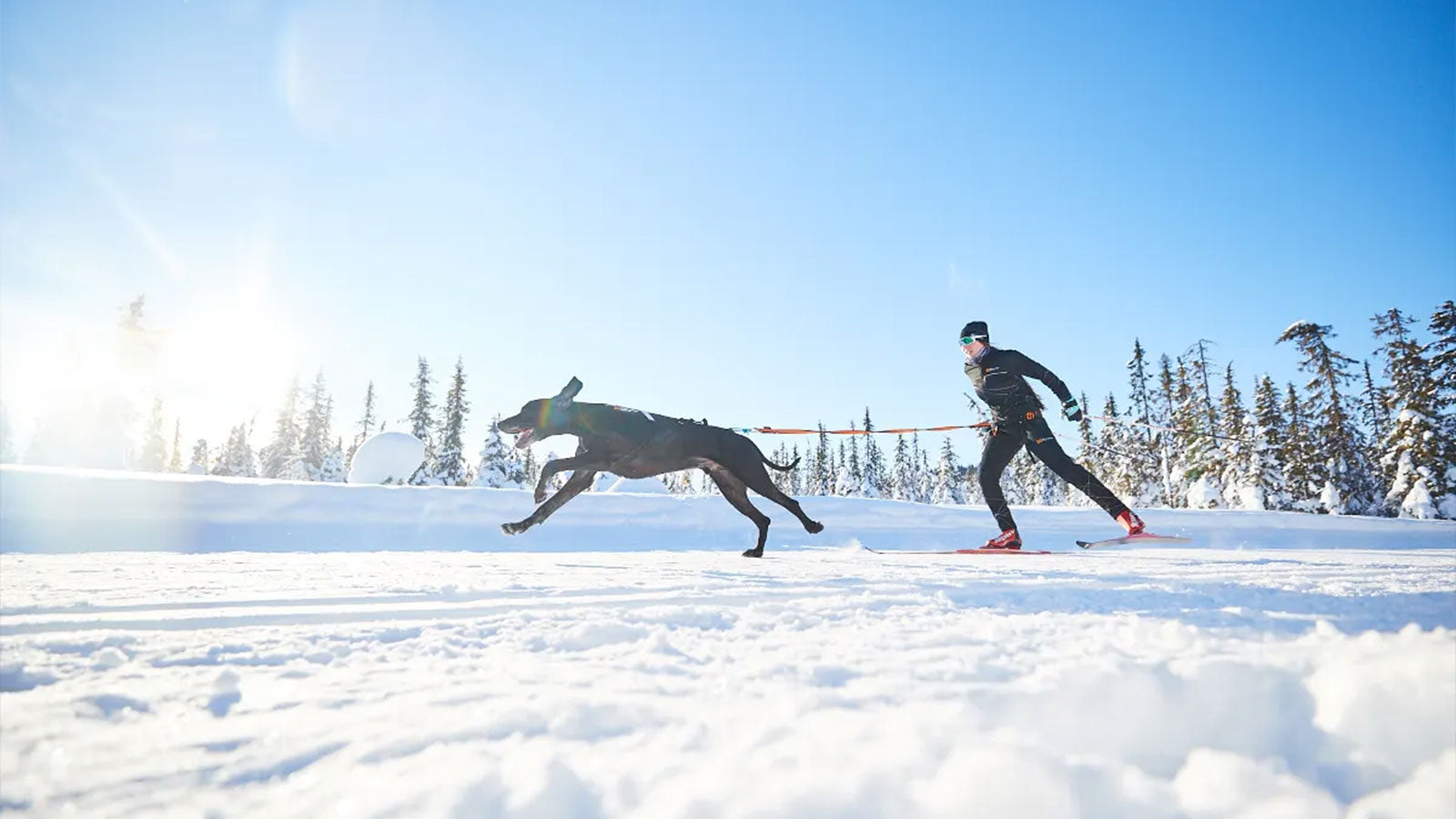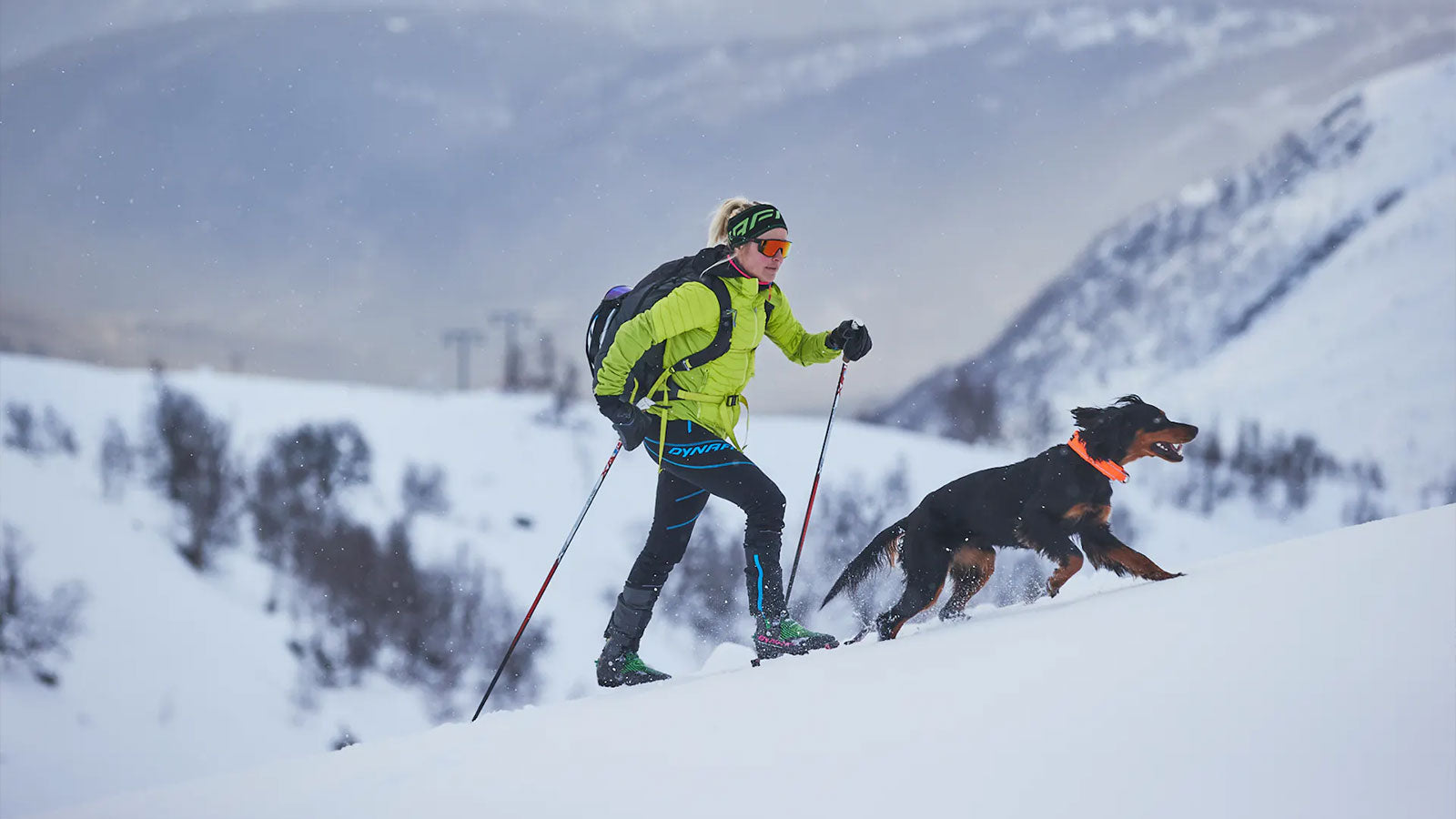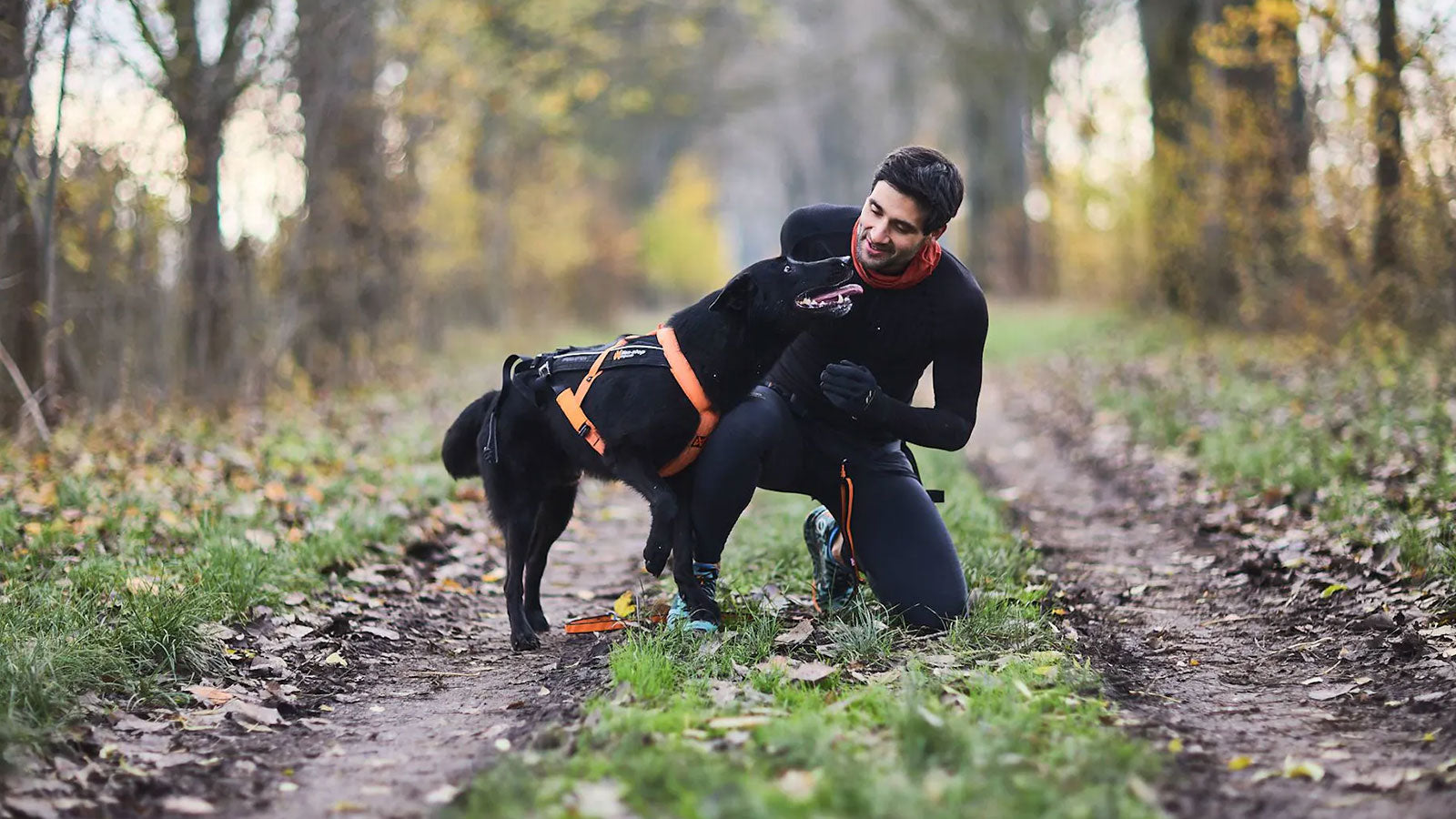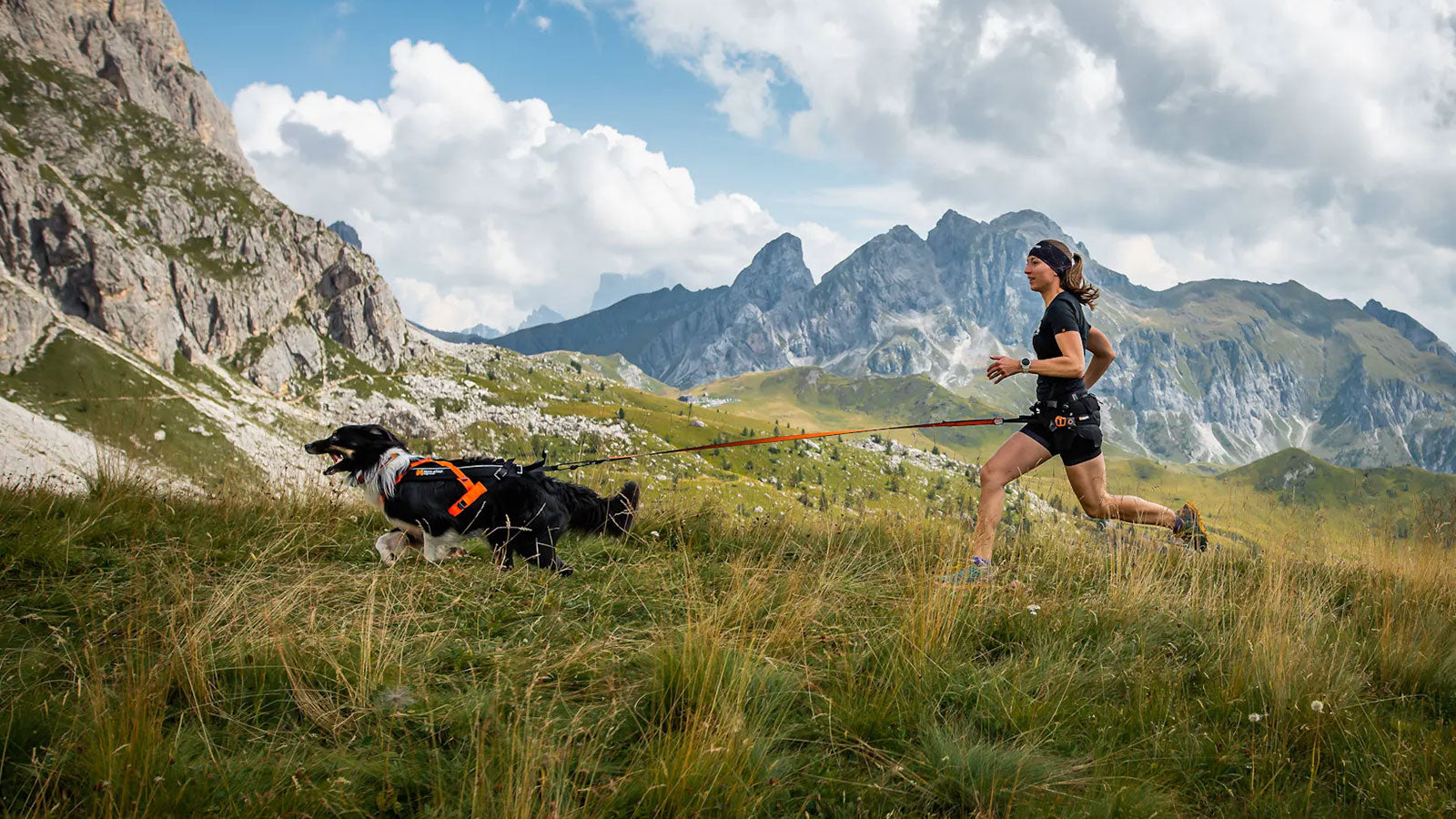Skiing with dogs, known as skijoring (pronounced ski-jawr-ing, meaning "ski driving"), is a dog-powered sport where one dog or a team of dogs pulls a skier. Skijoring can also be done with horses or vehicles.
Skijoring with dogs has its origin in dog mushing, where dogs pull the musher on a sled. However, a sled and a full pack of dogs were not always necessary or convenient. In Scandinavia, skijoring with dogs started as an effective way of getting from A to B. Scandinavians brought this mode of transportation to other countries, including America, in the late 19th century. Skiing with dogs is now a very popular activity in Scandinavian countries, both recreationally and competitively. When hitting the cross-country trails in winter, you are very likely to meet dogs of all shapes and sizes having fun with their owners in the snow. The interest in dog skijoring is also growing rapidly in other countries worldwide.
Cross-country skiing with dogs is a fun activity you should definitely try! To ensure a safe and positive experience for yourself and your dog, you need to get the right gear and develop some skills before hitting the trails together for the first time. In this skijoring guide, we will share our athletes' best tips for beginners.
Can My Dog Do Skijoring?
Dogs of all shapes and sizes can do skijoring, as long as they are healthy and fit for the challenge. However, you should always adjust the pace and distance to your dog’s abilities and let them decide the speed. Puppies or young dogs should not do skijoring until their bodies are fully grown.
Skijoring is usually done with one or two dogs. When skijoring with two dogs, you can use a Y-leash, as well as a neckline that will help keep your dogs together.
The best dogs for skijoring are usually breeds that are born with an instinct to pull, like Huskies, Samoyeds, or Alaskan Malamutes. At the elite level, the most common breeds are German Shorthaired Pointers (GSP) and mixed breeds like Greysters or Eurohounds. These dogs are fast, strong, and love to run!
Can small dogs be used for skijoring? Of course! They love to run as much as their bigger companions. You will not feel their pull force as much as with a 30-kilo/66 lbs dog, but skijoring is a great activity for small dogs too.
Many athletes started skiing with their family dogs. Breeds like Border Collies, Labradors, Malinois, German Shepherds, Rhodesian Ridgebacks, Cocker Spaniels, Vizslas, and Golden Retrievers are all suitable for skijoring.
Skiing with dogs is an excellent way of satisfying their need for physical and mental stimulation. It is natural for dogs to be active. Running can help address problems such as separation anxiety, stress, destructive behavior, and boredom. Exercising will also help your dog avoid becoming overweight and improve their overall health. The cool winter temperatures are also ideal for training dogs without the risk of overheating.
Can I Do Skijoring?
Everyone can enjoy skijoring! This activity is gentle on your body, and if you should fall, the snow will usually give you a soft landing.
Before skiing with your dog for the first time, you should practice cross-country skiing without a dog to make sure you can maneuver your skis and stop. This will keep you, your dog, and everyone you meet along the trail safe.
When skiing, you can choose between two techniques: classic and skating. Classic is the easiest for beginners, as the movement is similar to walking. Skating requires more skill and is the technique used for competitive skijoring.

Skijoring Equipment
When skijoring, your dog should wear a skijoring dog harness that allows them to move and breathe freely. You and your dog are connected with an elastic skijoring lead, attached to your skijoring belt. A belt allows your arms to move freely, which is essential when skiing with ski poles.
Dog booties protect your dog’s paws from chunks of snow and ice as well as frostbite. Paw ointment will help prevent cracks and dryness.
After skijoring, we put on warm and dry clothes for ourselves. Don’t forget to take care of your dog as well! A warm dog jacket can be used after skiing for optimum recovery and when skiing on really cold days.
You can learn more about gear for skiing with dogs in this article. We have also put together a skijoring set with the equipment needed to start skijoring with your dog.
For yourself, warm and functional clothing is recommended. A wool base layer and wool socks will keep you warm and comfortable even if sweaty. For competitions or high-intensity training sessions, a racesuit will provide you with maximum freedom of movement and prevent you from getting too warm. However, when skiing with some extra help from your dog, you might get cold. Wearing a warm jacket is recommended. Also, remember your gloves, beanie, and multiscarf.
When skijoring with dogs, you help your dog move forward. To do this, you need to have cross-country skis rather than alpine skis, which are commonly used for skijoring with horses or vehicles. Your skis should not have steel edges or sharp tips.
How to Teach Your Dog Skijoring
No snow? No problem! You can still train your dog to skijor. Practicing foundation skills in advance will make the transition to snow and skis easier for you and your dog.
First of all, you should teach your dog how to pull.
Teaching your dog to stand still and line out while you are getting ready and putting on your skis is also a useful skill. If your dog is moving while doing this, you might lose your balance!
Skijoring is a high-speed activity. Teaching your dog skijoring commands like turning left, right, or slowing down makes skiing together more fun and safe. You will probably overtake other skiers along the way. You should practice passing others so that you are prepared for this.
If your dog is reactive to other dogs, ski-training is excellent. When skiing, you can use your pole as an extension of your arm to correct your dog. That does not mean that you can hit your dog – the pole should only be used to guide your dog in the right direction and work as a barrier towards the other dog, says 25-time gold medalist Lena Boysen Hillestad.
Skis might look or sound strange to a dog that has never seen them before. To prevent your dog from getting scared, you should introduce them gradually to your skijoring equipment.
It’s not just "plug and play". You want to give your dog a positive experience from the start, says Viktor Sinding-Larsen. He has several medals from World Championships, European Championships, and Norwegian Championships in skijoring.
You can start by letting your dog sniff and examine the gear, then pick up your skis and walk slowly next to your dog. If your dog is fine with that, you can let them run free while you are skiing before being attached for the first time.
Remember to always warm your dog up before skijoring and cool down after. With a warm-up, you prepare the body physically and mentally for the activity. With a cool-down, you prepare your dog for rest. Warming up and cooling down will help your dog feel better, perform optimally, and remain injury-free.
Skijoring Etiquette
If you plan to go skijoring with your dog, make sure dogs are allowed on the trails and check whether you have to keep them leashed or not. Check your local rules and regulations in advance.
To become the most popular dog owner on the trails, you are also advised to:
- Always pick up your dog’s waste.
- Have control of your dog. This is important both when leashed and running free.
- Announce your arrival. People might not expect to be overtaken by a dog, and it could scare them if they are not prepared. Some people attach a tiny bell to their dog’s harness for this purpose.
- If the snow is fresh and the trail was just groomed, consider doing your training a bit later. Also, try to avoid letting your dog run on the classic tracks, which will leave paw prints. You can train your dog to run on the side of the track if you are classic skiing.
- Be positive and polite! Give skiers with dogs a good name.
Skijoring Competitions
If you like skijoring, you can enter a skijoring race. Mushing organizations usually have a schedule of skijoring competitions. You can also find official and unofficial competitions on social media.
If you need help finding competitions in your area, you can contact the local club.
Before participating in your first skijoring race, you need to get familiar with the rules that apply to you, your dog, and the equipment.
The International Federation of Sleddog Sports (IFSS) organizes World Championships and European Championships on snow. Most national and local sled dog clubs follow the rules of this organization.
Within skijoring, you can compete in several disciplines:
- 1-dog and 2-dog skijoring
- 1-dog and 1-4 dog pulk
- Combined race with skijoring and pulk stages
- Relay with all legs in pulk style, skijoring, or mixed.
A pulk is a small sled that is pulled between the dog and the skier.
Skijoring is great fun regardless of whether you compete at the top level or do it as a hobby. If you like dog-powered sports, you can also try canicross or bikejoring during the dryland season.






Κοινοποίηση:
Best tips for backpacking with a dog
The essential gear for Canicross